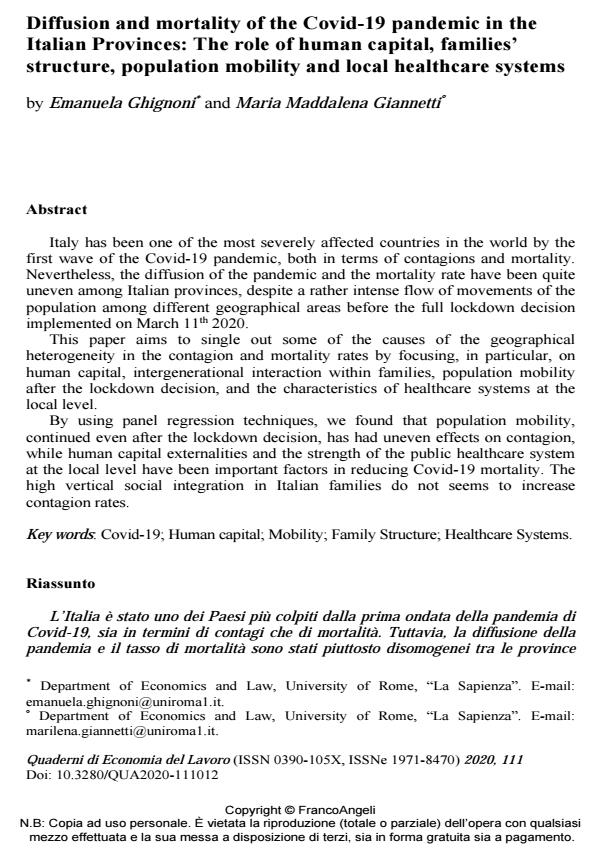Diffusion and mortality of the Covid-19 pandemic in the Italian Provinces: The role of human capital, families' structure, population mobility and local healthcare systems
Journal title QUADERNI DI ECONOMIA DEL LAVORO
Author/s Emanuela Ghignoni, Maria Maddalena Giannetti
Publishing Year 2021 Issue 2020/111
Language English Pages 26 P. 263-288 File size 3010 KB
DOI 10.3280/QUA2020-111012
DOI is like a bar code for intellectual property: to have more infomation
click here
Below, you can see the article first page
If you want to buy this article in PDF format, you can do it, following the instructions to buy download credits

FrancoAngeli is member of Publishers International Linking Association, Inc (PILA), a not-for-profit association which run the CrossRef service enabling links to and from online scholarly content.
L’Italia è stato uno dei Paesi più colpiti dalla prima ondata della pandemia di Covid-19, sia in termini di contagi che di mortalità. Tuttavia, la diffusione della pandemia e il tasso di mortalità sono stati piuttosto disomogenei tra le province italiane, nonostante un intenso flusso di movimenti della popolazione tra le diverse aree geografiche del paese prima del lockdown dell’11 marzo 2020. Questo articolo si propone di individuare alcune delle cause dell’eterogeneità geografica del contagio e del tasso di mortalità, concentrandosi in particolare sul ruolo del capitale umano, dell’interazione intergenerazionale all’interno delle famiglie, della mobilità della popolazione dopo la decisione di lockdown e delle caratteristiche dei sistemi sanitari a livello locale. Tramite l’utilizzo di tecniche panel, troviamo che la mobilità della popolazione, parzialmente continuata anche con il lockdown, ha avuto effetti disomogenei sull’espansione del contagio, mentre le esternalità del capitale umano e l’estensione del sistema sanitario pubblico a livello locale sono stati fattori importanti per ridurre la mortalità da Covid-19. L’elevata integrazione intergenerazionale delle famiglie italiane non sembra aver aumentato i tassi di contagio.
Keywords: Covid-19; Human capital; Mobility; Family Structure; Healthcare Systems.
Emanuela Ghignoni, Maria Maddalena Giannetti, Diffusion and mortality of the Covid-19 pandemic in the Italian Provinces: The role of human capital, families' structure, population mobility and local healthcare systems in "QUADERNI DI ECONOMIA DEL LAVORO" 111/2020, pp 263-288, DOI: 10.3280/QUA2020-111012